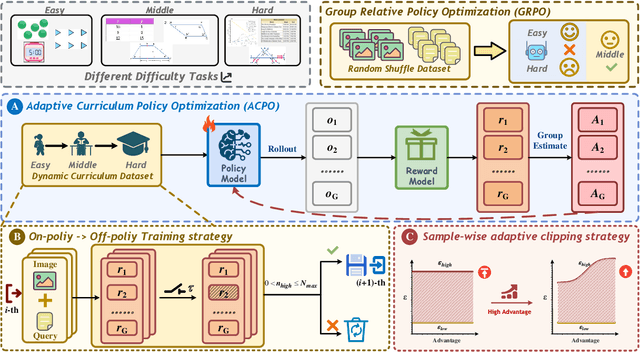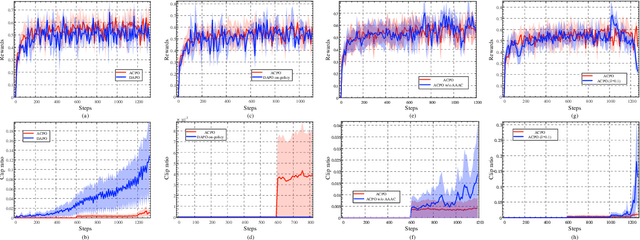Jian Zhu
University of British Columbia
Understanding In-Context Learning Beyond Transformers: An Investigation of State Space and Hybrid Architectures
Oct 27, 2025Abstract:We perform in-depth evaluations of in-context learning (ICL) on state-of-the-art transformer, state-space, and hybrid large language models over two categories of knowledge-based ICL tasks. Using a combination of behavioral probing and intervention-based methods, we have discovered that, while LLMs of different architectures can behave similarly in task performance, their internals could remain different. We discover that function vectors (FVs) responsible for ICL are primarily located in the self-attention and Mamba layers, and speculate that Mamba2 uses a different mechanism from FVs to perform ICL. FVs are more important for ICL involving parametric knowledge retrieval, but not for contextual knowledge understanding. Our work contributes to a more nuanced understanding across architectures and task types. Methodologically, our approach also highlights the importance of combining both behavioural and mechanistic analyses to investigate LLM capabilities.
ACPO: Adaptive Curriculum Policy Optimization for Aligning Vision-Language Models in Complex Reasoning
Oct 01, 2025



Abstract:Aligning large-scale vision-language models (VLMs) for complex reasoning via reinforcement learning is often hampered by the limitations of existing policy optimization algorithms, such as static training schedules and the rigid, uniform clipping mechanism in Proximal Policy Optimization (PPO). In this work, we introduce Adaptive Curriculum Policy Optimization (ACPO), a novel framework that addresses these challenges through a dual-component adaptive learning strategy. First, ACPO employs a dynamic curriculum that orchestrates a principled transition from a stable, near on-policy exploration phase to an efficient, off-policy exploitation phase by progressively increasing sample reuse. Second, we propose an Advantage-Aware Adaptive Clipping (AAAC) mechanism that replaces the fixed clipping hyperparameter with dynamic, sample-wise bounds modulated by the normalized advantage of each token. This allows for more granular and robust policy updates, enabling larger gradients for high-potential samples while safeguarding against destructive ones. We conduct extensive experiments on a suite of challenging multimodal reasoning benchmarks, including MathVista, LogicVista, and MMMU-Pro. Results demonstrate that ACPO consistently outperforms strong baselines such as DAPO and PAPO, achieving state-of-the-art performance, accelerated convergence, and superior training stability.
Generative Diffusion Contrastive Network for Multi-View Clustering
Sep 11, 2025Abstract:In recent years, Multi-View Clustering (MVC) has been significantly advanced under the influence of deep learning. By integrating heterogeneous data from multiple views, MVC enhances clustering analysis, making multi-view fusion critical to clustering performance. However, there is a problem of low-quality data in multi-view fusion. This problem primarily arises from two reasons: 1) Certain views are contaminated by noisy data. 2) Some views suffer from missing data. This paper proposes a novel Stochastic Generative Diffusion Fusion (SGDF) method to address this problem. SGDF leverages a multiple generative mechanism for the multi-view feature of each sample. It is robust to low-quality data. Building on SGDF, we further present the Generative Diffusion Contrastive Network (GDCN). Extensive experiments show that GDCN achieves the state-of-the-art results in deep MVC tasks. The source code is publicly available at https://github.com/HackerHyper/GDCN.
CTA-Flux: Integrating Chinese Cultural Semantics into High-Quality English Text-to-Image Communities
Aug 20, 2025Abstract:We proposed the Chinese Text Adapter-Flux (CTA-Flux). An adaptation method fits the Chinese text inputs to Flux, a powerful text-to-image (TTI) generative model initially trained on the English corpus. Despite the notable image generation ability conditioned on English text inputs, Flux performs poorly when processing non-English prompts, particularly due to linguistic and cultural biases inherent in predominantly English-centric training datasets. Existing approaches, such as translating non-English prompts into English or finetuning models for bilingual mappings, inadequately address culturally specific semantics, compromising image authenticity and quality. To address this issue, we introduce a novel method to bridge Chinese semantic understanding with compatibility in English-centric TTI model communities. Existing approaches relying on ControlNet-like architectures typically require a massive parameter scale and lack direct control over Chinese semantics. In comparison, CTA-flux leverages MultiModal Diffusion Transformer (MMDiT) to control the Flux backbone directly, significantly reducing the number of parameters while enhancing the model's understanding of Chinese semantics. This integration significantly improves the generation quality and cultural authenticity without extensive retraining of the entire model, thus maintaining compatibility with existing text-to-image plugins such as LoRA, IP-Adapter, and ControlNet. Empirical evaluations demonstrate that CTA-flux supports Chinese and English prompts and achieves superior image generation quality, visual realism, and faithful depiction of Chinese semantics.
NanoControl: A Lightweight Framework for Precise and Efficient Control in Diffusion Transformer
Aug 14, 2025Abstract:Diffusion Transformers (DiTs) have demonstrated exceptional capabilities in text-to-image synthesis. However, in the domain of controllable text-to-image generation using DiTs, most existing methods still rely on the ControlNet paradigm originally designed for UNet-based diffusion models. This paradigm introduces significant parameter overhead and increased computational costs. To address these challenges, we propose the Nano Control Diffusion Transformer (NanoControl), which employs Flux as the backbone network. Our model achieves state-of-the-art controllable text-to-image generation performance while incurring only a 0.024\% increase in parameter count and a 0.029\% increase in GFLOPs, thus enabling highly efficient controllable generation. Specifically, rather than duplicating the DiT backbone for control, we design a LoRA-style (low-rank adaptation) control module that directly learns control signals from raw conditioning inputs. Furthermore, we introduce a KV-Context Augmentation mechanism that integrates condition-specific key-value information into the backbone in a simple yet highly effective manner, facilitating deep fusion of conditional features. Extensive benchmark experiments demonstrate that NanoControl significantly reduces computational overhead compared to conventional control approaches, while maintaining superior generation quality and achieving improved controllability.
FLUX-Makeup: High-Fidelity, Identity-Consistent, and Robust Makeup Transfer via Diffusion Transformer
Aug 07, 2025Abstract:Makeup transfer aims to apply the makeup style from a reference face to a target face and has been increasingly adopted in practical applications. Existing GAN-based approaches typically rely on carefully designed loss functions to balance transfer quality and facial identity consistency, while diffusion-based methods often depend on additional face-control modules or algorithms to preserve identity. However, these auxiliary components tend to introduce extra errors, leading to suboptimal transfer results. To overcome these limitations, we propose FLUX-Makeup, a high-fidelity, identity-consistent, and robust makeup transfer framework that eliminates the need for any auxiliary face-control components. Instead, our method directly leverages source-reference image pairs to achieve superior transfer performance. Specifically, we build our framework upon FLUX-Kontext, using the source image as its native conditional input. Furthermore, we introduce RefLoRAInjector, a lightweight makeup feature injector that decouples the reference pathway from the backbone, enabling efficient and comprehensive extraction of makeup-related information. In parallel, we design a robust and scalable data generation pipeline to provide more accurate supervision during training. The paired makeup datasets produced by this pipeline significantly surpass the quality of all existing datasets. Extensive experiments demonstrate that FLUX-Makeup achieves state-of-the-art performance, exhibiting strong robustness across diverse scenarios.
ZIPA: A family of efficient models for multilingual phone recognition
May 29, 2025Abstract:We present ZIPA, a family of efficient speech models that advances the state-of-the-art performance of crosslinguistic phone recognition. We first curated IPAPack++, a large-scale multilingual speech corpus with 17,132 hours of normalized phone transcriptions and a novel evaluation set capturing unseen languages and sociophonetic variation. With the large-scale training data, ZIPA, including transducer (ZIPA-T) and CTC-based (ZIPA-CR) variants, leverage the efficient Zipformer backbones and outperform existing phone recognition systems with much fewer parameters. Further scaling via noisy student training on 11,000 hours of pseudo-labeled multilingual data yields further improvement. While ZIPA achieves strong performance on benchmarks, error analysis reveals persistent limitations in modeling sociophonetic diversity, underscoring challenges for future research.
CaseReportBench: An LLM Benchmark Dataset for Dense Information Extraction in Clinical Case Reports
May 22, 2025Abstract:Rare diseases, including Inborn Errors of Metabolism (IEM), pose significant diagnostic challenges. Case reports serve as key but computationally underutilized resources to inform diagnosis. Clinical dense information extraction refers to organizing medical information into structured predefined categories. Large Language Models (LLMs) may enable scalable information extraction from case reports but are rarely evaluated for this task. We introduce CaseReportBench, an expert-annotated dataset for dense information extraction of case reports, focusing on IEMs. Using this dataset, we assess various models and prompting strategies, introducing novel approaches such as category-specific prompting and subheading-filtered data integration. Zero-shot chain-of-thought prompting offers little advantage over standard zero-shot prompting. Category-specific prompting improves alignment with the benchmark. The open-source model Qwen2.5-7B outperforms GPT-4o for this task. Our clinician evaluations show that LLMs can extract clinically relevant details from case reports, supporting rare disease diagnosis and management. We also highlight areas for improvement, such as LLMs' limitations in recognizing negative findings important for differential diagnosis. This work advances LLM-driven clinical natural language processing and paves the way for scalable medical AI applications.
Self-Learning Hyperspectral and Multispectral Image Fusion via Adaptive Residual Guided Subspace Diffusion Model
May 17, 2025Abstract:Hyperspectral and multispectral image (HSI-MSI) fusion involves combining a low-resolution hyperspectral image (LR-HSI) with a high-resolution multispectral image (HR-MSI) to generate a high-resolution hyperspectral image (HR-HSI). Most deep learning-based methods for HSI-MSI fusion rely on large amounts of hyperspectral data for supervised training, which is often scarce in practical applications. In this paper, we propose a self-learning Adaptive Residual Guided Subspace Diffusion Model (ARGS-Diff), which only utilizes the observed images without any extra training data. Specifically, as the LR-HSI contains spectral information and the HR-MSI contains spatial information, we design two lightweight spectral and spatial diffusion models to separately learn the spectral and spatial distributions from them. Then, we use these two models to reconstruct HR-HSI from two low-dimensional components, i.e, the spectral basis and the reduced coefficient, during the reverse diffusion process. Furthermore, we introduce an Adaptive Residual Guided Module (ARGM), which refines the two components through a residual guided function at each sampling step, thereby stabilizing the sampling process. Extensive experimental results demonstrate that ARGS-Diff outperforms existing state-of-the-art methods in terms of both performance and computational efficiency in the field of HSI-MSI fusion. Code is available at https://github.com/Zhu1116/ARGS-Diff.
Other Vehicle Trajectories Are Also Needed: A Driving World Model Unifies Ego-Other Vehicle Trajectories in Video Latant Space
Mar 12, 2025Abstract:Advanced end-to-end autonomous driving systems predict other vehicles' motions and plan ego vehicle's trajectory. The world model that can foresee the outcome of the trajectory has been used to evaluate the end-to-end autonomous driving system. However, existing world models predominantly emphasize the trajectory of the ego vehicle and leave other vehicles uncontrollable. This limitation hinders their ability to realistically simulate the interaction between the ego vehicle and the driving scenario. In addition, it remains a challenge to match multiple trajectories with each vehicle in the video to control the video generation. To address above issues, a driving \textbf{W}orld \textbf{M}odel named EOT-WM is proposed in this paper, unifying \textbf{E}go-\textbf{O}ther vehicle \textbf{T}rajectories in videos. Specifically, we first project ego and other vehicle trajectories in the BEV space into the image coordinate to match each trajectory with its corresponding vehicle in the video. Then, trajectory videos are encoded by the Spatial-Temporal Variational Auto Encoder to align with driving video latents spatially and temporally in the unified visual space. A trajectory-injected diffusion Transformer is further designed to denoise the noisy video latents for video generation with the guidance of ego-other vehicle trajectories. In addition, we propose a metric based on control latent similarity to evaluate the controllability of trajectories. Extensive experiments are conducted on the nuScenes dataset, and the proposed model outperforms the state-of-the-art method by 30\% in FID and 55\% in FVD. The model can also predict unseen driving scenes with self-produced trajectories.
 Add to Chrome
Add to Chrome Add to Firefox
Add to Firefox Add to Edge
Add to Edge